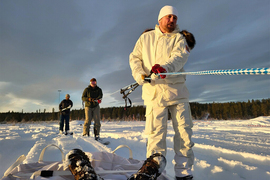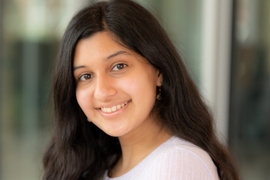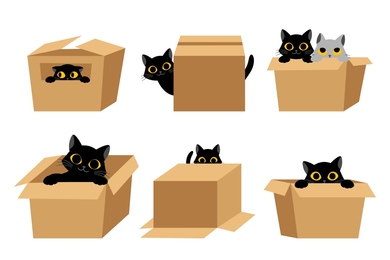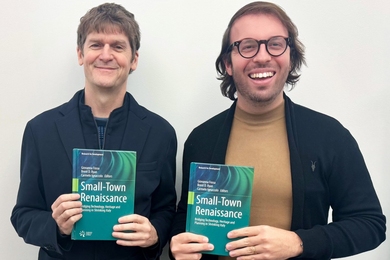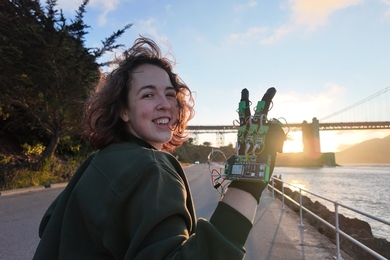Growing up in Coeur d’Alene, Idaho, with engineer parents who worked in the state’s silver mining industry, MIT senior Maria Aguiar developed an early interest in materials. The star garnet, the state’s mineral, is still her favorite. It’s a sheer coincidence, though, that her undergraduate thesis also focuses on garnets.
Her research explores ways to manipulate the magnetic properties of garnet thin films — work that can help improve data storage technologies. After all, says Aguiar, a major in the Department of Materials Science and Engineering (DMSE), technology and energy applications increasingly rely on the use of materials with favorable electronic and magnetic properties.
Passionate about engineering in high school — science fiction was also her jam — Aguiar applied and got accepted to MIT. But she had only learned about materials engineering through a Google search. She assumed she would gravitate toward aerospace engineering, astronomy, or even physics, subjects that had all piqued her interest at one time or another.
Aguiar was indecisive about a major for a while but began to realize that the topics she enjoyed would invariably center on materials. “I would visit an aerospace museum and would be more interested in the tiles they used in the shuttle to tolerate the heat. I was interested in the process to engineer such materials,” Aguiar remembers.
It was a first-year pre-orientation program (FPOP), designed to help new students test-drive majors, that convinced Aguiar that materials engineering was a good fit for her interests. It helped that the DMSE students were friendly and approachable. “They were proud to be in that major, and excited to talk about what they did,” Aguiar says.
During the FPOP, Associate Professor James LeBeau, a DMSE expert in transmission electron microscopy, asked students about their interests. When Aguiar piped up, saying she loved astronomy, LeBeau compared the subject to microscopy.
“An electron microscope is just a telescope in reverse,” she recalls him saying. Instead of looking at something far away, you go from big to small — zooming in to see the finer details. That comparison stuck with Aguiar and inspired her to pursue her first Undergraduate Research Opportunities Program (UROP) project with Lebeau, where she learned more about microscopy.
Drawn to magnetic materials
It was class 3.152 (Magnetic Materials), taught by Professor Caroline Ross, that stoked Aguiar’s interest in magnetic materials. The subject matter was fascinating, Aguiar says, and she knew related research would make important contributions to modern data storage technology. After starting a UROP in Ross’s magnetic materials lab in the spring of her junior year, Aguiar was hooked, and the work eventually morphed into her undergraduate thesis, “Effects of Annealing on Atomic Ordering and Magnetic Anisotropy in Iron Garnet Thin Films.”
The broad goal of her work was to understand how to manipulate materials’ magnetic properties, such as anisotropy — the tendency of a material’s magnetic properties to change depending on which direction they are measured in. It turns out that changing where certain metal atoms — or cations — sit in the garnet’s crystal structure can influence this directional behavior. By carefully arranging these atoms, researchers can “tune” garnet films to deliver novel magnetic properties, enabling the design of advanced materials for electronics.
When Aguiar joined the lab, she began working with doctoral candidate Allison Kaczmarek, who was investigating the connection between cation ordering and magnetic properties for her PhD thesis. Specifically, Kaczmarek was studying the growth and characterization of garnet films, evaluating different ways to induce cation ordering by varying the parameters in the pulsed laser deposition process — a technique that fires a laser at a target material (in this case, garnet), vaporizing it so it deposits onto a substrate, such as glass. Adjusting variables such as laser energy, pressure, and temperature, along with the composition of the mixed oxides, can significantly influence the resulting film.
Aguiar studied one specific parameter: annealing — heating a material to a high temperature before cooling it. The strengthening technique is often used to alter the way atoms are arranged in a material. “So far, I have found that when we anneal these films for times as short as five minutes, the film gets closer to preferring out-of-plane magnetization,” Aguiar says. This property, known as perpendicular magnetic anisotropy, is significant for magnetic memory applications because it offers advantages in performance, scalability, and energy efficiency.
“Maria has been very reliable and quick to be independent. She picks things up very quickly and is very thoughtful about what she’s doing,” Kaczmarek says. That thoughtfulness showed early on. When asked to identify an optimal annealing temperature for the films, Aguiar didn’t just run tests — she first conducted a thorough literature review to understand what had been worked out before, then carefully tested films at different temperatures to find one that worked the best.
Kaczmarek first got to know Aguiar as a teaching assistant for class 3.030 (Microstructural Evolution of Materials), taught by Professor Geoffrey Beach. Even before starting the UROP in Ross’ lab, Aguiar had shared a clear research goal: to gain hands-on experience with advanced techniques such as X-ray diffraction, vibrating sample magnetometry, and ferromagnetic resonance — tools typically used by more senior researchers. “That’s a goal she has certainly achieved,” Kaczmarek says.
Beyond the lab, beyond MIT
Outside of the lab, Aguiar combines her love of materials with a strong sense of community outreach and social cohesion. As co-president of the Society of Undergraduate Materials Scientists in DMSE, she helps organize events that make the department more inclusive. Class dinners are great fun — many seniors recently went to a Cambridge restaurant for sushi — and “Materials Week” every semester functions primarily as a recruitment event for new students. A hot cocoa event near the winter holidays combined seasonal cheer with class evaluations — painful for some, perhaps, but necessary for improving instruction.
After graduating this spring, Aguiar is looking forward to pursuing graduate school at Stanford University and is setting her sights on teaching. She loved her time as a teaching assistant for the popular first-year classes 3.091 (Introduction to Solid-State Chemistry) and 3.010 (Structure of Materials), earning her an undergraduate student teaching award.
Ross is convinced that Aguiar is a strong fit for graduate studies. “For graduate school, you need academic excellence and technical skills like being good in the lab, and Maria has both. Then there are the soft skills, which have to do with how well organized you are, how resilient you are, how you manage different responsibilities. Usually, students learn them as they go along, but Maria is well ahead of the curve,” Ross says.
“One thing that makes me hopeful for Maria’s time in grad school is that she is very broadly interested in a lot of aspects of materials science,” Kaczmarek adds.
Aguiar’s passion for the subject spilled over into a fun side project: a DMSE-exclusive “Meow-terials Science” T-shirt she designed — featuring cats doing familiar lab experiments — was a hit among students.
She remains endlessly fascinated by the materials around her, even in the water bottle she drinks from every day. “Studying materials science has changed the way I see the world. I can pick up something as ordinary as this water bottle and think about the metallurgical processing techniques I learned from my classes. I just love that there’s so much to learn from the everyday.”






